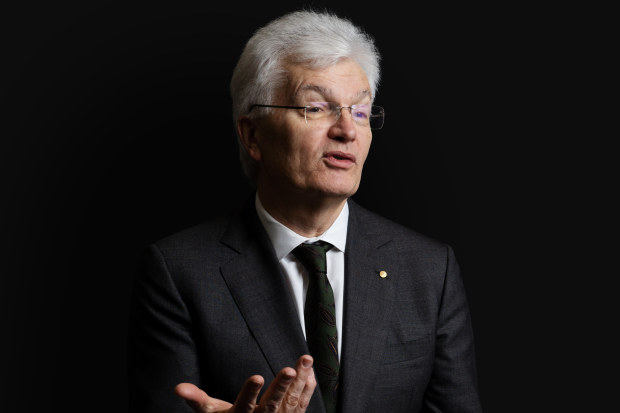Glyn Davis wants the public service to surrender control
The federal public sector boss wants to flip big government and put the locals in charge. He admits it will not be easy.

Glyn Davis’ nudge for government to go local is a significant signal that a redesign of public service delivery and contracting out is under way.
Davis is head of the Prime Minister’s Department and the Australian Public Service. In his yearly address this week, he noted that for almost 40 years the push has been to privatise and outsource government.

Professor Glyn Davis says bureaucrats can’t solve Indigenous disadvantage from their Canberra offices. Alex Ellinghausen
As a result, the federal public sector is a third smaller than when governments owned and operated a suite of businesses, from banks to airlines.
The sell-off was accompanied by the “marketisation” of services, including employment, disability, childcare, aged care, prisons and hospitals. Various approaches from full outsourcing to partial private delivery were adopted.
The essence of these approaches was to give citizens a choice in their provider, rather than being forced into a government monopoly. (Prisoners, of course, don’t get such a choice.)
As Davis noted, the results have been mixed. He cited studies that private construction and outsourcing of probation had been conspicuous failures.
“There were measurable gains in cost and service quality, but sometimes those were achieved by pushing the most difficult, and expensive, cases back to government.”
Pointing to the demise of the Commonwealth Employment Service, Davis cited a recent parliamentary report that concluded there was no longer an effective, coherent national employment services system.
It had been replaced with an “inefficient, outsourced, fragmented social security compliance management system that sometimes gets someone a job against all odds”.
Davis noted the decision to outsource should be a pragmatic rather than an ideological choice. The important decision was when to use the market and when not to, noting what had worked and what had not.
In that regard, there had been meaningful gains where services were standardised, such as waste collection and cleaning.
He said the government would need to continue to buy in specific expertise, most notably advanced technology skills.
Community sets priorities
But it was his focus on localism, developed around partnerships, that was most significant.
The CES had been an example of a highly localised service that tapped the knowledge of community employers to place prospective workers. Like local banking, those days are long gone, and the challenge is how to get back into these communities.
Davis has been heavily influenced by his time at the Paul Ramsay Foundation, where he played a leading role in supporting a locally driven Indigenous program in Bourke, western NSW.
Called the Maranguka Just Reinvest program, it involves pooling funds for community, government and philanthropy organisations to reduce incarceration and crime, notably domestic violence.
The Maranguka model works because the community sets priorities and directs expenditures. The service savings from reduced violence are funnelled back to the community.
Davis also cited Namyangju, a city in South Korea, as a poster child for hybrid social services. It runs a one-stop shop for services from healthcare to legal aid and financial counselling. A mix of public and private local bodies enjoy a high degree of autonomy in helping their clients.
A powerful alternative
However, as Davis admitted, this empowered community model will require fundamental changes in how government operates.
The Productivity Commission has already noted how lousy the feds are at local engagement, with a recent report damning Canberra’s amateurish attempts to embrace a partnership approach to the Closing the Gap initiatives.
Surrendering control of funding and program design to community leadership does not sit comfortably with electoral cycles or with ministers keen to make announcements.
“Instead it makes officials truly servants of the public,” Davis wryly observed.
But, as Davis concluded, empowered communities could provide a powerful alternative to remedying the consistent failure of many social programs to remedy disadvantage and intergenerational poverty.
“We will never close the gap if public servants in Canberra think we can solve the housing, employment and educational challenges of Papunya,” Davis said, referring to an Indigenous community 240 kilometres from Alice Springs.
There are already powerful tidal changes that are forcing governments to directly engage with the citizenry they serve.
The timing is right for a more fundamental rethink of what a true partnership model looks like.
The new disability reforms, for example, will require a sophisticated and scalable system to assess personal needs. This drops the former focus on functional impairment, which had in practice medicalised disability by requiring participants to meet clinical tests.
Lifting local capability will be central to the success of any community-based program. Disadvantage is often a function of community dysfunction, and effective partnering with leaders to gain the confidence of locals will require skills that no Canberra department possesses.
State and local governments clearly are better equipped to work with regions and townships, but with Canberra being inexorably drawn into the care economy, the timing is right for a more fundamental rethink of what a true partnership model looks like.
At the core, going local requires sophisticated engagement skills, something at which Canberra is notoriously old-school. Witness the countless top-down “consultations” agencies undertake every day of the week.
More broadly, if Davis’ hybrid model is to succeed, it will need to be able to scale. All this takes money and, to date, various attempts to get private capital into social services, such as social impact bonds, have not been able to scale.
Developing a localised funding model that gives longer-term certainty and fuels sustainable investment will be critical if Davis’ place-based delivery is going to emerge as something beyond a boutique play.
Introducing your Newsfeed
Follow the topics, people and companies that matter to you.
Find out moreRead More
Latest In Federal
Fetching latest articles